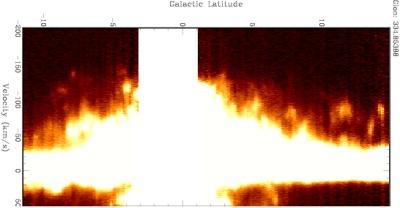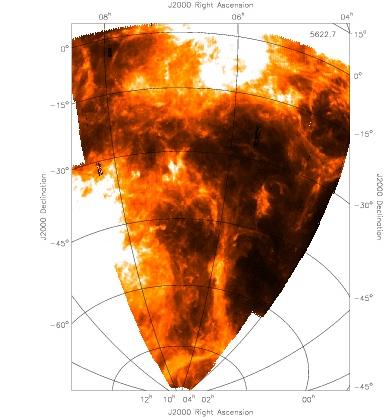The Galactic All-Sky Survey (GASS)
|
N. McClure-Griffiths (ATNF); A. Ford (Swinburne University); D. J. Pisano (NRL, USA); L. Staveley-Smith (ATNF); P. Kalberla (University of Bonn, Germany); B. Gibson (Swinburne University) & F. J. Lockman (NRAO Greenbank, USA) Galactic neutral hydrogen (HI) emission is observed in all directions on the sky. Our knowledge of the structure of the HI distribution, however, has been limited to angular scales of typically one degree, provided by the Leiden- Dwingeloo Survey and the complementary Argentinian IAR survey of the Southern sky. While high resolution Galactic Plane surveys like the Canadian and Southern Galactic Plane Surveys (Taylor et al. 2003; McClure-Griffiths et al. 2005) have allowed us to carefully explore the bulk of the Galactic HI emission in the disk, these surveys are not very sensitive and are restricted to a few degrees around the Galactic Plane, leaving most of the volume of the Galaxy unexplored on scales less than a degree. Recently, high resolution observations of targeted areas away from the plane have shown that there is an enormous amount of HI structure on small angular scales, which is not detected with the angular resolution of the current all-sky surveys. In order to understand the small-scale structure of HI in the halo, we have recently begun the Galactic All-Sky Survey (GASS) with the Parkes multibeam receiver. GASS is a fully sampled survey of Galactic HI south of declination = 0° with 15 arcminute resolution, a velocity resolution of one km s-1 and a sensitivity limit of 70 milliKelvin. GASS will be used to answer questions about the kinematics of gas in the halo, the connection of the disk to the halo and the nature of HI structure in the halo. The evolution of the Milky Way is significantly impacted by the two-way flow of gas and energy between the Galactic disk and the halo. It has long been known that the HI halo extends far beyond the disk. However, because of the poor resolution of existing surveys, little is know about the origin and spatial structure of HI in the Galactic halo. In recent years high resolution studies with the Green Bank Telescope (GBT) have shown that the Galactic HI halo contains a plethora of cold, small structures on scales less than 30 arcminutes that appear to be in Galactic rotation (Lockman 2002). An example of such clouds from the GASS data is shown in Figure 1. These clouds may account for as much as half of the mass of the halo, but their origin and their dynamics are not known. Are they part of "Galactic fountain" gas that has been expelled from the disk and is now falling back towards it? GASS will provide a complete inventory of these halo clouds. Using this inventory the GASS team aims to determine the fraction of the halo mass in small clouds and the scale height of clouds, and to investigate the origin and physical state of the clouds. GASS will also provide an unsurpassed resource for studying the distribution, origin and evolution of intermediate and high velocity clouds. In and near our Galaxy, HI with velocities deviating from Galactic rotation is very common. Historically, gas clouds with large non-rotational velocities (above about 100 kilometres per second relative to the local standard of rest) have been called "High-Velocity Clouds" (HVCs). It is now known that these represent a variety of phenomena: some HVCs are probably related to a galactic fountain; some are tidal debris connected to the Magellanic Stream or other satellites; some may be infalling intergalactic gas (e.g. Complex C); and some may be associated with dark matter halos and be the remnants of the formation of the Local Group. The structure and distribution of high velocity gas probes tidal streams and the building blocks of galaxies providing critical information on the evolution in the Milky Way system. Though a great deal is known about the classification of HVCs, their nature and origin is still very unclear. Recent high angular and spectral resolution surveys, such as the Magellanic Stream survey of Brüns et al. (2005) or the CHVC survey of Braun, Burton, & Chengular (2001), have resolved physical and spectral structure in high and intermediate velocity clouds, demonstrating that there is much to be learned about the nature of these clouds on small scales. As a sensitive, unbiased, high-resolution survey of a large fraction of the sky, GASS will contribute much to understanding the origin of HI structure in the halo and the nature of HVCs. GASS will use more than 1500 hours with the multibeam on the Parkes radio telescope over the course of the next two years. The need for high spectral resolution on all 13 beams of the multibeam has led to a new hybrid correlator mode, in which the multibeam correlator is used for the inner seven beams and the wideband correlator is used for the outer six beams. GASS pilot observations started in September 2004 and the full survey with the new hybrid correlator, in January 2005. The preliminary maps from GASS are spectacular. Figure 2 is an example of one velocity channel at 5 km s-1, taken from the first observing run covering right ascensions from 4 - 8 h and all declinations south of 0°. We look forward to many beautiful images over the next two years.
References: |
|


